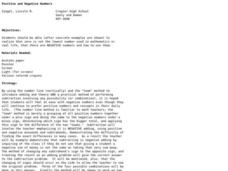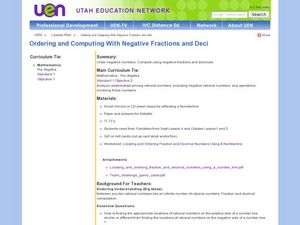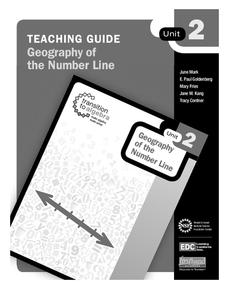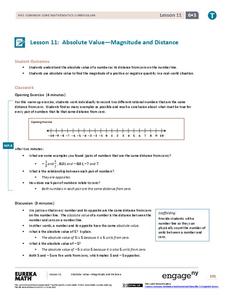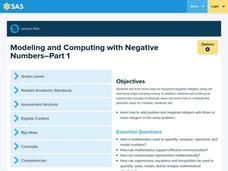EngageNY
Applying the Properties of Operations to Multiply and Divide Rational Numbers
Use properties to evaluate several multiplications and divisions. The 16th lesson in a series of 25 demonstrates to scholars how they can utilize properties of operations to evaluate complex numerical expressions involving multiplication...
Buffalo State
Adding and Subtracting Integers Unit
Just because one integer is larger than another doesn't mean it will make sense right away. Go beyond note taking and show learners, through the use of algebra tiles and a Four-Pan Algebra Balance, how the numbers relate to one...
Curated OER
Signed Numbers and Order of Operations Ii
In this signed numbers worksheet, 8th graders simplify integer problems through addition, multiplication, division, or subtraction. The majority of the 26 problems contain a minimum of 3 integers, and some more. Four problems contain...
Curated OER
Positive and Negative Dominoes
Young scholars play dominoes with regular dominoes rules with some modification. Every student keep score. Every count be used--not just the 5's as in dominoes. They count outside points using white dots as positive and red dots as...
Curated OER
Understanding Oxidation Numbers
Students review atomic numbers, positive and negative charges, and the periodic table. They examine the relationships among protons and electrons, location of various elements, electron energy levels, and oxidation numbers.
Curated OER
Naturally Magnetic Elements
Students explore naturally magnetic elements. In this magnets lesson, students examine the periodic table of elements. Students discover the parts of an atom and determine which three elements are magnetic.
Curated OER
The Fall of the Dollar
Students synthesize the basic workings of the international market for foreign exchange, especially how exchange rates are determined, how the value of a nation's currency is connected to its international trade, and how governmental...
Curated OER
Slope of a Function
Seventh graders explore the concept of the slope of a line. They see how to determine the direction of the line. Also students are introduced to the slope intercept algebraic expression in conjunction with the rise/run.
Curated OER
Lesson 3: Number Sense
Learners solve word problems using number sense. They convert fractions to decimals and mixed numbers. Pupils determine if a given fraction is greater or less than another fraction, and order numbers on a number line.
Willow Tree
Scatterplots and Stem-and-Leaf Plots
Is there a correlation between the number of cats you own and your age? Use a scatter plot to analyze these correlation questions. Learners plot data and look for positive, negative, or no correlation, then create stem-and-leaf plots to...
Bob Prior
The Order of Operations
Your learners use many different number representations like positive and negative integers, exponents, radicals, and combinations of operations as they learn and strengthen their use of the order of operations. Thoughtfully organized to...
Alabama Learning Exchange
Exponents and Division
Create a human fraction to learn about division of exponents. Scholars develop the rule for division of exponents by being part of a human fraction to explore and justify the rule. They also consider zero exponents and negative exponents.
Virginia Department of Education
The Modern Model of Atomic Structure
The difference between atomic mass and atomic number can be confusing for some young chemists. Help your class better understand the concepts by allowing them to sketch an atom on paper and then discuss their experience. Upon completion...
Curated OER
Positive and Negative Numbers
High schoolers discover negative numbers and how to use them by using the number line and the "team" method.
Curated OER
Integer Arithmetic
Students solve integer-based problems. They add and subtract integers as well find missing integers. They represent a scenario involving positive and negative integers and solve it.
Curated OER
Modular Mathematics
Learners are introduced to modular mathematics. They start by making clocks for different bases. They use their clocks to count, using the base, and then finding the mod or remainder. They explore both positive and negative numbers with...
Curated OER
A Human Number Line
Sixth graders create a human number line through use of symbols, equality, inequality, addition, subtraction, solving equations and inequalities
Curated OER
Ordering and Computing with Negative Fractions and Decimals
Seventh graders explore the concept of computing negative fractions and decimals. In this negative fractions and decimals lesson, 7th graders compare ordering positive fractions to ordering negative fractions. Students use mirrors to see...
Curated OER
Cherries Still Positive, Lemons Still Negative
Third graders explore positive and negative integers. This follows a lesson entitled, Cherries Are Positive, Lemons Are Negative and uses Cherry heads and Lemon heads.
Education Development Center
Geography of the Number Line
It's more than just numbers on a line, its an organizational, mental math machine to help learners understand the value of numbers. The tool is handy when introducing positive and negative integers to see their values and...
EngageNY
Absolute Value—Magnitude and Distance
Do you want to use the resource? Absolutely. Scholars learn about absolute value and its relation to magnitude and distance on a number line. They compare numbers in context by applying absolute value.
EngageNY
Efficacy of Scientific Notation
How many times could California fit into the entire United States? Pupils use scientific notation to find the answer to that question in the 12th installment of 15 lessons. It asks scholars to write numbers in scientific notation and...
Curated OER
Adding and Subtracting Integers (Positive and Negative Numbers)
In this math worksheet, young scholars solve 15 problems in which positive and negative integers are added and subtracted. The answers are given in a separate column on the page.
Curated OER
Dividing with Fractions
Use paper strips or models to relate division problems to division of fraction problems. Since the materials can be broken up, it helps them to show how they can complete repeated subtraction with fractions and not just whole numbers.













